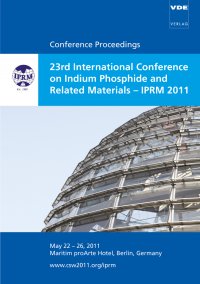Metamorphic and Non-conventional 'Buffer' Layers
Conference: IPRM 2011 - 23th International Conference on Indium Phosphide and Related Materials
05/22/2011 - 05/26/2011 at Berlin, Germany
Proceedings: IPRM 2011
Pages: 4Language: englishTyp: PDF
Personal VDE Members are entitled to a 10% discount on this title
Authors:
Kuech, T. F.; Jha, S.; Wiedmann, M. K.; Paulson, C. A. (Department of Chemical and Biological Engineering, University of Wisconsin - Madison, 1415 Engineering Dr., Madison, Wisconsin 53706, USA)
Babcock, S. E. (Materials Science and Engineering, University of Wisconsin - Madison, 1415 Engineering Dr., Madison, Wisconsin 53706, USA)
Kuan, T. S. (Department of Physics, State University of New York, Albany, NY, 12222, USA)
Mawst, L. J.; Kirch, J.; Kimd, Tae Wan (Department of Electrical and Computer Engineering, University of Wisconsin - Madison, 1415 Engineering Dr., Madison, Wisconsin 53706, USA)
Abstract:
The integration of large lattice mismatch materials through epitaxial growth requires the introduction of a controlled interface or transitional region, often referred to as a buffer layer. These, often relatively thick, transitional layers allow for a change in lattice parameter and a reduction in the threading dislocation density attributed to the required mismatch dislocations in the strain-relaxed materials. New designs for these transitional layers are emerging which allow for a reduction in buffer layer thickness, smoother morphology, and lower threading dislocation densities. These metamorphic buffer layers allowed the development of devices accessing new ranges of performance and, in the case of optical devices, wavelength regimes. The reduction of the buffer layer to a 'single interface' may be possible through the use of nano-patterning and advanced processing which provides control over the initial phases of nucleation and strain relaxation.


